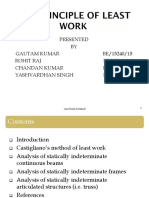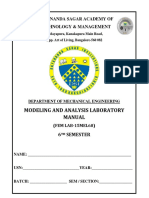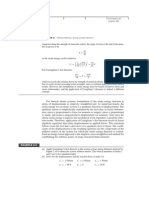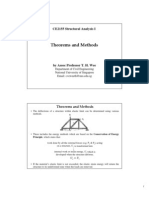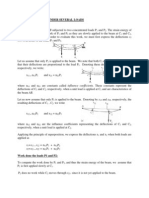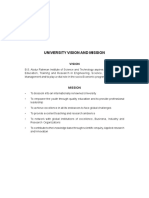Convergence Criteria
Convergence Criteria
Uploaded by
ooCopyright:
Available Formats
Convergence Criteria
Convergence Criteria
Uploaded by
ooOriginal Description:
Copyright
Available Formats
Share this document
Did you find this document useful?
Is this content inappropriate?
Copyright:
Available Formats
Convergence Criteria
Convergence Criteria
Uploaded by
ooCopyright:
Available Formats
Convergence Criteria
Convergence Criteria
Finite Element Analysis of Static Problems
For static finite element analysis, the equation representing equilibrium can be
written in the following matrix form:
KU = P F ,
where P represents the vector of applied loads, F the vector of internal forces, and
U the vector of current nodal displacements. In non-linear analysis the load P is
applied in a series of load steps P(1) , P(2) , P(3) ,
Finite element analysis involves solving the equation above for U . For the n-th
load step, the equation is often solved through iterations of the form:
KU ( i +1) = P( n ) F( i ) for iterations i = 0, 1, 2,
The Solution Process, Convergence and Stopping Criterion
The finite element solution process and the definition of convergence are best
explained with the simple case of a single force applied to a non-linear spring. In
this case, the relationship between the applied load P and displacement U is:
KU = P ,
where K = K (U ) is the non-linear stiffness of the spring, which is a function of
displacement. The non-linear response of the spring to loads is shown in Figure 1.
Let us assume that we already have the solution (displacement U ( n ) ) after
application of load step P( n ) to the spring, and the task now is to determine the
spring response the displacement increment U illustrated in Figure 1 below
with application of load step P( n +1) . Prior to applying the new load step, the resisting
(internal) force F(0) in the spring due to its current deformed state is in equilibrium
with the applied (external) load P( n ) .
First, we evaluate the tangent stiffness, K (0) , at the origin of the displacement-load
curve. Since Phase2 generally uses the initial stiffness method, this stiffness will be
used throughout all iterations for the new load step. Next, we calculate the current
displacement increment and update the solution:
Phase2 Theory
Convergence Criteria
K (0) U (1) = P( n +1) F(0)
1
U (1) = K (0)
( P( n +1) F(0) )
U ( n +1) = U ( n ) + U (1)
From the current displacement state we can calculate the internal force, F(1) , in the
spring (see Figure 1). At this stage, the current force error or load imbalance
P( n +1) F(1) is quite large. From Figure 1 it is evident that a key aim of the iterations
is to reduce the load imbalance to zero, or at least a very small number.
For the next iteration, we start at the new, more accurate estimate of the
displacement U ( n +1) and apply the same load step P( n +1) . This time we obtain a
displacement increment, U (2) which is smaller than the increment U (1) of the
previous iteration. Following the procedures described previously, we calculate an
updated internal force, F(2) , that is closer to equilibrating the applied load.
Figure 1: The non-linear response of a spring to applied loads. This problem has a
single degree of freedom. The figure also illustrates the iterative finite element
procedure for determining the springs behaviour under applied loads.
Typically, with continued iterations, not only does the load imbalance P( n +1) F( i )
grow smaller and smaller, the displacement increments U ( i ) also approach zero,
and updates of U ( n +1) approach the true solution. In order not to iterate
unnecessarily long, we can decide to terminate calculations when the results are
sufficiently close according to some stopping criterion or criteria.
Phase2 Theory
Convergence Criteria
Phase2 allows you to choose one of the following two options for stopping criteria:
Absolute Energy
Square Root Energy
as defined by the following equations. Although the equations below are written in
vector notation, they can be readily applied to our simple, scalar special case.
Absolute Energy Criterion
Energy convergence is satisfied when:
UT(i ) ( P(n ) F(i ) )
UT(0) ( P( n ) F(0) )
< ( specified energy tolerance)
Square Root Energy Criterion
Energy convergence is satisfied when:
Nj=1
Nj=1
(( p
(( p
( n ), j
f ( i ), j ) u( i ), j
( n ), j
f (0), j ) u(0), j
)
)
< ( specified energy tolerance)
where p( n ), j , f ( i ), j , f (0), j , u( i ), j and u(0), j are the components (N in total) of P(n ) ,
F( i ) , F(0) , U ( i ) and U (0) , respectively.
These criteria simply mean that, for a given load step, we cease iterations when the
energy imbalance of a current state becomes a small fraction of the initial energy
imbalance (energy imbalance on the first iteration). If this condition is not satisfied
during a specified maximum number of iterations, the solution process is deemed
not to have converged.
Other Stopping Criteria
Literature on finite element analysis describes other stopping criteria. Two of the
most commonly used are Force and Displacement.
Force Criterion
Stop iterations when the current force imbalance becomes a small fraction of the
total applied force (current load level).
Phase2 Theory
Convergence Criteria
Displacement Criterion
Stop iterations when the current displacement increment becomes a small fraction
of the initial displacement.
Sometimes combinations of all these criteria are used. In our experience, for the
range of problems solved with Phase2, the energy criteria have been the most
consistent and reliable.
Phase2 Theory
You might also like
- Daryl L. Logan - A First Course in The Finite Element Method-CL Engineering - Cengage Learning (2016) (1) (0060-0080)Document21 pagesDaryl L. Logan - A First Course in The Finite Element Method-CL Engineering - Cengage Learning (2016) (1) (0060-0080)Nurul FaoziahNo ratings yet
- Compiled E105 E111Document36 pagesCompiled E105 E111MingNo ratings yet
- The Principle of Least Work PDFDocument17 pagesThe Principle of Least Work PDFGautam100% (1)
- HW 3 Solution - CE 634 - Spring 2021Document6 pagesHW 3 Solution - CE 634 - Spring 2021oluwatobi ajayiNo ratings yet
- Homework 2Document7 pagesHomework 2Chinny LyheangNo ratings yet
- Fe 1DDocument40 pagesFe 1Daap1100% (2)
- Questions Papers M.techDocument299 pagesQuestions Papers M.techRavikiran JadhavNo ratings yet
- 053 - CE8021, CE6701 Structural Dynamics and Earthquake Engineering - 2 Marks 2Document116 pages053 - CE8021, CE6701 Structural Dynamics and Earthquake Engineering - 2 Marks 2Ankit Jose Antony0% (1)
- AE6601 - Finite Element Method Two MarksDocument5 pagesAE6601 - Finite Element Method Two MarksAravind Phoenix100% (2)
- Fea QBDocument11 pagesFea QBPradeepNo ratings yet
- 15mel68 - Cama LabDocument121 pages15mel68 - Cama LabDr-Nagvendra Kumar Kanoje0% (1)
- Session 56: Theory of Non-Linear Analysis: ELEATION's ANSYS Basic To Professional Training ProgramDocument11 pagesSession 56: Theory of Non-Linear Analysis: ELEATION's ANSYS Basic To Professional Training ProgramrajuNo ratings yet
- Frequency of Free Damped Vibrations (Viscous Damping)Document8 pagesFrequency of Free Damped Vibrations (Viscous Damping)ذوالفقار علي حسينNo ratings yet
- Shape Functions in Finite Element Method: HandoutsDocument22 pagesShape Functions in Finite Element Method: HandoutssyampnaiduNo ratings yet
- 2 Marks With AnswersDocument16 pages2 Marks With AnswersKarthik SoundarrajanNo ratings yet
- Matrix M of SA QuestionsDocument14 pagesMatrix M of SA Questionsrajivkannan100% (1)
- 4 Node QuadDocument27 pages4 Node QuadMathiew EstephoNo ratings yet
- Unit 4Document108 pagesUnit 4Mainali Ishu100% (1)
- FEM L1 (C)Document27 pagesFEM L1 (C)zinilNo ratings yet
- Lecture 02 Energy-Rayleigh-Ritz 2015Document40 pagesLecture 02 Energy-Rayleigh-Ritz 2015Mustapha BelloNo ratings yet
- IS 883 Design of Structural Timber in Building-Code of Pract PDFDocument18 pagesIS 883 Design of Structural Timber in Building-Code of Pract PDFHusseinali Hussein100% (2)
- Som Unit 1 and 2 Question BankDocument7 pagesSom Unit 1 and 2 Question Bankrkrajesh86No ratings yet
- Finite Element Analysis QuestionsDocument8 pagesFinite Element Analysis QuestionsSatwikMohanty100% (2)
- Group-A (Multiple Choice Questions) : Answer: (D)Document5 pagesGroup-A (Multiple Choice Questions) : Answer: (D)kuldip mukherjeeNo ratings yet
- ME524 1st Midterm Exam Spring 2022 Model SolutionDocument3 pagesME524 1st Midterm Exam Spring 2022 Model SolutionSulaiman AL MajdubNo ratings yet
- Unit 3Document34 pagesUnit 3moondonoo7No ratings yet
- Assi 03interpolation Functions and SimplexDocument2 pagesAssi 03interpolation Functions and SimplexRamesh Bammankatti100% (1)
- Dynamic Analysis FEMDocument9 pagesDynamic Analysis FEMbhanuNo ratings yet
- Ma2264 - Numerical MethodsDocument26 pagesMa2264 - Numerical MethodsSUNILKHUNTIA1988No ratings yet
- Analysis of Durability of High Performance Concrete Using Artificial Neural NetworksDocument19 pagesAnalysis of Durability of High Performance Concrete Using Artificial Neural NetworksVishnu GopalakrishnanNo ratings yet
- 4-Factor of Safety and Indicators of FailureDocument30 pages4-Factor of Safety and Indicators of FailureDipakNo ratings yet
- H2.4.10-Response To Step and Ramp ForcesDocument4 pagesH2.4.10-Response To Step and Ramp ForcesMD NayeemNo ratings yet
- Corrosion Effects On The Seismic Response of Existing RC Frames Designed According To Different Building CodesDocument17 pagesCorrosion Effects On The Seismic Response of Existing RC Frames Designed According To Different Building CodesAlex PantiruNo ratings yet
- Q&a FeaDocument19 pagesQ&a FeaKishoreNo ratings yet
- Simply Supported Beam-FrequenciesDocument2 pagesSimply Supported Beam-FrequenciesIvan Jovanovic0% (1)
- Mechanics of Solids CE 1201Document12 pagesMechanics of Solids CE 1201G Sri SoumyaNo ratings yet
- Minimum Potential EnergyDocument9 pagesMinimum Potential EnergyBright MuzaNo ratings yet
- Harmonic Large Mass Method PDFDocument78 pagesHarmonic Large Mass Method PDFkrishnaNo ratings yet
- Iare Sa-Ii Lecture Notes PDFDocument195 pagesIare Sa-Ii Lecture Notes PDFAkhilesh B.M100% (1)
- FEM-2 Marks and 16 Marks AnsDocument34 pagesFEM-2 Marks and 16 Marks AnsDineshNo ratings yet
- Constant Strain Triangle - Stiffness Matrix DerivationDocument33 pagesConstant Strain Triangle - Stiffness Matrix DerivationM.Saravana Kumar..M.ENo ratings yet
- 364 - CE8402 Strength of Materials II (SOM 2) - Question BankDocument19 pages364 - CE8402 Strength of Materials II (SOM 2) - Question BankPRASANTHNo ratings yet
- Part 11 - CH 10 Mdof - Free VibrationDocument19 pagesPart 11 - CH 10 Mdof - Free Vibrationmacynthia26No ratings yet
- Linear Dynamics: Code - Aster, Salome-Meca Course MaterialDocument22 pagesLinear Dynamics: Code - Aster, Salome-Meca Course MaterialStefano MilaniNo ratings yet
- Theory of Elasticity and Plasticity Model QuestionsDocument2 pagesTheory of Elasticity and Plasticity Model Questionsrameshbabu_1979No ratings yet
- Tutorial:: Er. Manoj Sharma Wagle Date of Submission: July 15, 2018Document3 pagesTutorial:: Er. Manoj Sharma Wagle Date of Submission: July 15, 2018JONAMNo ratings yet
- Introduction To Numerical Methods For Variational Problems PDFDocument216 pagesIntroduction To Numerical Methods For Variational Problems PDFmottenerNo ratings yet
- Numerical Evaluation of Dynamic ResponseDocument47 pagesNumerical Evaluation of Dynamic ResponseARUN RAJNo ratings yet
- Previous Year Question Paper With AnswersDocument108 pagesPrevious Year Question Paper With AnswersTejasPatilNo ratings yet
- Finite Element Analysis AE2351Document5 pagesFinite Element Analysis AE2351Aghil BuddyNo ratings yet
- Equivalent Nodal ValuesDocument27 pagesEquivalent Nodal Values1005641No ratings yet
- Numerical Methods and Implementation in Geotechnical Engineering – Part 1From EverandNumerical Methods and Implementation in Geotechnical Engineering – Part 1No ratings yet
- Non-Linear Analysis Solution StrategiesDocument5 pagesNon-Linear Analysis Solution StrategiesPiyush SinghNo ratings yet
- Structural Analysis - Theorems and MethodsDocument24 pagesStructural Analysis - Theorems and MethodsHiew Ching YongNo ratings yet
- Notes On Potential Energy Methods: Buckling: Based On The Original Prepared by Dr. T. Koyama, Spring 2009Document19 pagesNotes On Potential Energy Methods: Buckling: Based On The Original Prepared by Dr. T. Koyama, Spring 2009rajeshmteccivilenggNo ratings yet
- The Finite Element Method For The Analysis of Non-Linear and Dynamic SystemsDocument8 pagesThe Finite Element Method For The Analysis of Non-Linear and Dynamic SystemsTarun SachdevaNo ratings yet
- Force MethodDocument4 pagesForce MethodpraveennagarajanNo ratings yet
- Castigliano's Theorem in Indeterminate Structures - Rev01Document12 pagesCastigliano's Theorem in Indeterminate Structures - Rev01Moganna GowdaNo ratings yet
- Work and Energy PrinciplesDocument12 pagesWork and Energy PrinciplesHernan Kennedy Ricaldi PorrasNo ratings yet
- Study Note - Castiglianos Method RevADocument9 pagesStudy Note - Castiglianos Method RevASboniso KhethukuthulaNo ratings yet
- Potential Flow:: 1.1 General FormulationDocument19 pagesPotential Flow:: 1.1 General FormulationJisoo Eric LeeNo ratings yet
- Learning Journal Unit 4 15-07-2021Document3 pagesLearning Journal Unit 4 15-07-2021Winnerton GeochiNo ratings yet
- LAS 2: Boyle's Law Pre-TestDocument4 pagesLAS 2: Boyle's Law Pre-TestSalve SerranoNo ratings yet
- 05a Practice Test Set 1 - Paper 2HDocument19 pages05a Practice Test Set 1 - Paper 2Hnaz2you100% (1)
- 2uz Secnary Air MalDocument12 pages2uz Secnary Air MalJansen BlancoNo ratings yet
- Prestressed Steel BeamDocument35 pagesPrestressed Steel BeamRestie TeanoNo ratings yet
- Schwinger Representation of Spin Hamiltonian: X y X y ZDocument2 pagesSchwinger Representation of Spin Hamiltonian: X y X y ZvujopklatNo ratings yet
- 033 - Flight Planning Monitoring - AnswersDocument109 pages033 - Flight Planning Monitoring - AnswersEASA ATPL Question Bank0% (1)
- B.Tech - Bio-Technology-newDocument162 pagesB.Tech - Bio-Technology-newDibyajyoti20 Das4001No ratings yet
- Unit 2.2 Radioactive DecayDocument66 pagesUnit 2.2 Radioactive DecayGabriel FungNo ratings yet
- Haloalkanes and HaloarenesDocument23 pagesHaloalkanes and HaloarenesCR7STUDIO 7No ratings yet
- Gantrail Welded Base Fixing: SpecificationsDocument2 pagesGantrail Welded Base Fixing: SpecificationsCarlos Augusto LancellottiNo ratings yet
- GE 110HP DC Trolley MotorDocument10 pagesGE 110HP DC Trolley MotorAnthony PetersNo ratings yet
- Aws Cloudshell: User GuideDocument62 pagesAws Cloudshell: User Guidealia khanNo ratings yet
- PT - Mathematics 10 - Q2Document3 pagesPT - Mathematics 10 - Q2JOBERT HERRERANo ratings yet
- LR 1702021903 Tesla ReprintDocument4 pagesLR 1702021903 Tesla ReprintDinca SimunicNo ratings yet
- 8series COMM ABDocument242 pages8series COMM ABAkbar SyawaludinNo ratings yet
- Temperature and Air PressureDocument29 pagesTemperature and Air PressureNicole Aizel Velardo BalanacNo ratings yet
- Implementation of The R.cuda - Los Module in The Open Source GRASS GIS by Using Parallel Computation On The NVIDIA CUDA Graphic CardsDocument6 pagesImplementation of The R.cuda - Los Module in The Open Source GRASS GIS by Using Parallel Computation On The NVIDIA CUDA Graphic CardsAndrej OstermanNo ratings yet
- Advanced Spreadsheet SkillsDocument25 pagesAdvanced Spreadsheet SkillsDONVIC 5No ratings yet
- Self Powered Relay-CGI14SEnglishDocument16 pagesSelf Powered Relay-CGI14SEnglishjoydip.dgp2152100% (2)
- Design of 230 KV Twin Bundle Double Circuit Overhead Transmission LineDocument4 pagesDesign of 230 KV Twin Bundle Double Circuit Overhead Transmission LineEditor IJTSRDNo ratings yet
- Power Plant FamiliarizationDocument74 pagesPower Plant Familiarizationashish2086100% (1)
- 255DSDocument2 pages255DSAlberto Moreno GarrigaNo ratings yet
- 05esprit de CorpsDocument33 pages05esprit de CorpsMarek KubisiakNo ratings yet
- Mac4861 2024 TL 102 0 BDocument231 pagesMac4861 2024 TL 102 0 BmongwanesNo ratings yet
- Inspection Report - Motor+16701004051+KT - 12V1600G80SDocument1 pageInspection Report - Motor+16701004051+KT - 12V1600G80SChristopherNo ratings yet
- SequencerDocument26 pagesSequenceranon_942178333No ratings yet
- Operating Systems Assignment: Department of Computer Science & EngineeringDocument4 pagesOperating Systems Assignment: Department of Computer Science & EngineeringSankalp JainNo ratings yet
- SX-final Spez MetDocument20 pagesSX-final Spez MetMitra MadaniNo ratings yet


